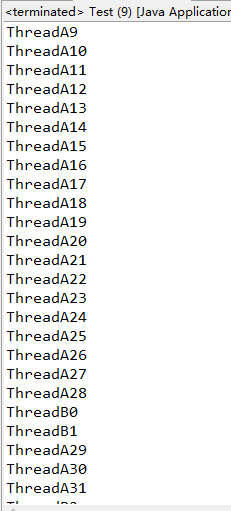synchronized用法
synchronized修饰的对象有几种:
-
修饰一个类:其作用的范围是synchronized后面括号括起来的部分,作用的对象是这个类的所有对象;
-
修饰一个方法:被修饰的方法称为同步方法,其作用的范围是整个方法,作用的对象是调用这个方法的对象;
-
修饰一个静态的方法:其作用的范围是整个方法,作用的对象是这个类的所有对象;
-
修饰一个代码块:被修饰的代码块称为同步语句块,其作用范围是大括号{}括起来的代码块,作用的对象是调用这个代码块的对象;
synchronized(this)是对象锁,如果有多个对象就有相对应的多个锁。(修饰一个代码块)
synchronized(类的名.class)是全局锁,不管有几个对象就公用一把锁。(修饰一个类)
方法内的同步代码块:
package test.synchronizedtest.test1; public class ObjectService { public void serviceMethodA(){ try { synchronized (this) { System.out.println("A begin time = " + System.currentTimeMillis()); Thread.sleep(2000); System.out.println("A end time = " + System.currentTimeMillis()); } } catch (InterruptedException e) { e.printStackTrace(); } } public void serviceMethodB(){ synchronized (this){ System.out.println("B begin time ="+System.currentTimeMillis()); System.out.println("B end time" + System.currentTimeMillis()); } } //测试同步代码块 synchronized public void serviceMethodC(String thread){ /*synchronized (this) { System.out.println("A begin time = " + System.currentTimeMillis()); Thread.sleep(2000); System.out.println("A end time = " + System.currentTimeMillis()); }*/ /*synchronized (this){ for(int i=0;i<50;i++){ System.out.println(thread + i); } }*/ /*for(int i=0;i<50;i++){ System.out.println(thread + i); }*/ synchronized (ObjectService.class){ for(int i=0;i<50;i++){ System.out.println(thread + i); } } } }
synchronized (this){...修饰对象,如果有多个对象就有相对应的多个锁。
synchronized (ObjectService.class){...不管有几个对象就公用一把锁。
线程类:
ThreadA:
package test.synchronizedtest.test1; public class ThreadA extends Thread{ private ObjectService service; public ThreadA(ObjectService service){ super(); this.service=service; } public void run(){ super.run(); //service.serviceMethodA(); service.serviceMethodC("ThreadA"); } }
ThreadB:
package test.synchronizedtest.test1; public class ThreadB extends Thread{ private ObjectService service; public ThreadB(ObjectService service){ super(); this.service=service; } public void run (){ super.run(); //service.serviceMethodB(); service.serviceMethodC("ThreadB"); } }
测试类Test:
package test.synchronizedtest.test1; public class Test { public static void main(String[] args) { ObjectService service = new ObjectService(); ObjectService service2 = new ObjectService(); ThreadA a = new ThreadA(service); a.setName("a"); a.start(); ThreadB b = new ThreadB(service2); b.setName("b"); b.start(); } }
synchronized (this){...输出结果:

不同对象对应不同的锁,线程交替执行。
synchronized (ObjectService.class){...输出结果:

不同的对象共用一个锁,当一个线程执行完后才能执行另一个线程。
总结:作用的对象是这个类的所有对象,则不同对象共用锁;否则,不同的对象对应不同的锁。